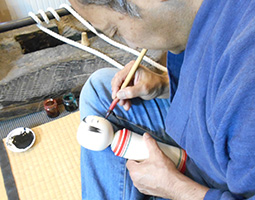March 2022
- English
- 日本語
The Kokeshi Dolls of Tohoku

Examples of new types of kokeshi 
Traditional kokeshi

Making the body of a kokeshi doll 
Decorating a kokeshi

Kokeshi are traditional wooden dolls from the Tohoku region of northeast Japan which typically feature a spherical head atop a cylindrical body with patterns painted on the body and expressions on the face. The dolls remain popular today as simple folk crafts. The artisans who create these dolls are working to pass on traditional techniques to the next generation while also enthusiastically working to create new and original kokeshi.

Since long ago, the mountain areas of the Tohoku region have been dotted with villages of woodturners who work wood with a lathei to create bowls, trays and more. The first kokeshi are said to have been toys made by these woodturners between jobs. The dolls, which combine a spherical head with a cylindrical body, have different characteristics based on where they were made, and each doll has a slightly different shape and expression. There are eleven traditional types of kokeshi still being made in the six prefectures of the Tohoku region, and among them, five typesii from Miyagi and Yamagata Prefectures are designated as traditional crafts by the national government.
For 200 years and more, kokeshi have been made as souvenirs mainly for visitors to hot spring areas, and that tradition continues today.
Okazaki Yasuo is an artisan who established the Kokeshi no Okajin workshop in the Naruko hot spring area and works as the executive director of the Miyagi Traditional Kokeshi Dolls Association. “In the past, farmers had a custom of visiting therapeutic baths during the off season to heal the fatigue of the year. They bought kokeshi to take home to their children as souvenirs.”
Kokeshi-making flourished through the Meiji period (1868–1912), but declined as Western dolls and plush toys became popular as toys for children. However, since the 1930s, antique lovers have sought out kokeshi as collectable folk crafts. During the postwar period of rapid growth (1960s and 70s), the dolls became popular once again as souvenirs and presents to take home when traveling to the Tohoku region.
There are six steps to creating a traditional kokeshi. For the Naruko Kokeshi made in the hot spring resort of Naruko in Miyagi Prefecture, the source wood is first cut from the tree and dried. Measurements are then taken and a block of wood is cut out. After the head and body have been turned on the lathe, a hole to accommodate the neck is carved into the body. The head is attached to the body using friction while the lathe is being turned. Finally, the face and body are painted and then finished with a coating of wax. The tight fit of the neck in the body is such that the doll squeaks when the head is turned. This process is carried out entirely by a single person, so even among the same types of dolls, each has a unique quality depending on the artisan, and because all the work is done by hand, no two kokeshi are alike.


Okazaki says, “So that kokeshi might bring a sense of calmness to those who see them, the facial expressions are the dolls’ most important features. It’s no exaggeration to say that it is the eyes and eyebrows, which are painted on first, that determine if the doll turns out good or not. But if you paint too carefully and the brush moves too slowly, the ink will smudge. You have to just paint all in one go.”
There are also some new kokeshi trends emerging. Among kokeshi fans this last ten years, there has been a sharp increase in young girls called “Koke-jyo,” and as a result, change has started to come to kokeshi-making. This includes the production of dolls that do not conform to the traditional shapes. Recently, cute kokeshi made for the Hina Matsuri (the annual doll festival for girls; see here) or designed with animal motifs have become popular, as have related products made for everyday use such as kokeshi penholders and even one doll with an LED that automatically illuminates when it falls over in an earthquake.
Okazaki, who turns 68 this year, works not only on traditional kokeshi but on original ones, as well. He says that the methods for creating both traditional and new kokeshi are fundamentally the same. Kokeshi artisans are working to create something new with techniques that have been passed down, further spread the allure of kokeshi, and connect with the next generation.
* A spinning machine used in woodcrafts and ceramics
** Togatta type, Yajiro type, Sakunami type, Hijiori type, and Naruko type

